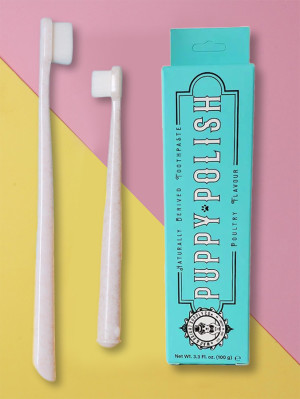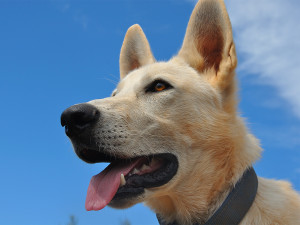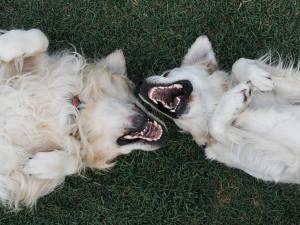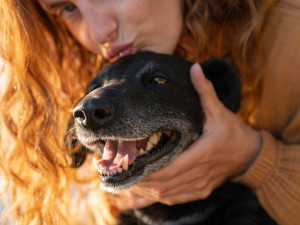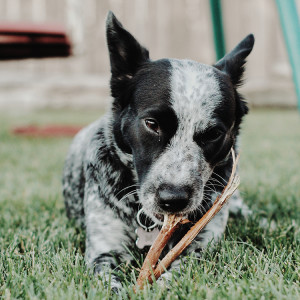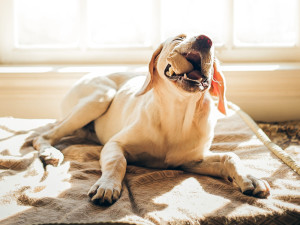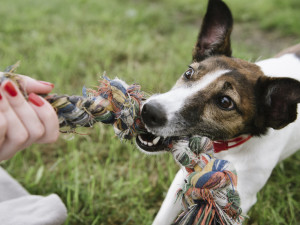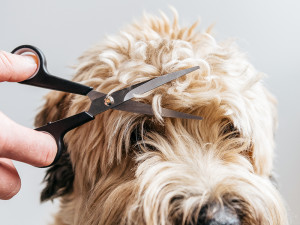What Is the Best Way to Clean a Dog’s Teeth?
In This Article:
How Do You Clean Your Dog’s Teeth? Best Way to Clean Dog’s Teeth Without Brushing Signs of Dental Problems in Dogs Preventing Dental Issues in Dogs
Puppy breath is cute, but doggie breath stinks. Regularly brushing your dog’s teeth with a pet-safe toothbrush and toothpaste is the best way to maintain their dental health at home. Additionally, providing dental chews and treats can help reduce plaque and tartar buildup.
How do you clean your dog’s teeth?
Periodontal disease is inflammation of the tissues that hold teeth in place. It’s one of the most common health issues in adult dogs, affecting over 80 percent of dogs age three and older. The best way to prevent dental disease in your dog is to be proactive in keeping their teeth clean, which means brushing their teeth. Here’s how to brush your dog’s teeth at home:
Have the right tools
You’ll need a dog-specific toothpaste and toothbrush. Never use human toothpaste to brush your dog’s teeth because many products have ingredients, like xylitol, that are toxic to dogs.
Get a dog-appropriate toothbrush. This can be a one specifically made for dogs, a baby toothbrush, or an over-the-finger toothbrush. You can also use a cloth to scrub your dog’s teeth, but bristles are more effective at removing plaque. Keep a few treats handy as rewards.
How much do you spend on your pet per year?
Practice getting a good look at your dog’s teeth.
Practice lifting your dog’s lips to get a good look at their teeth. It’s easiest to see the large canine teeth and the small incisors at the front of the mouth, but don’t stop there. Practice getting a good look at your dog’s cheek teeth, too. Do this when your dog is calm and relaxed, and reward them for being compliant.
Let your dog get used to the toothpaste.
Doggy toothpastes come in a variety of flavors like chicken, beef, fish, and vanilla mint. Find a flavor that’s enticing and that your dog will willingly lick off your finger.
Slowly introduce brushing.
Gently brush the teeth that are easiest to access to introduce your dog to the sensation. Use a gentle, circular motion to get plaque and debris off the teeth. It’s OK to start with the easy teeth and build up to the cheek teeth. You only need to brush the outside surfaces of your dog’s teeth. Salivary enzymes and professional cleanings will take care of the inside surfaces.
Be patient and take breaks as needed
The goal is to get up to a full minute of brushing every day. That may seem like a lot to both you and your dog in the beginning, so start with a goal of 10 seconds and build from there. And take breaks as needed, especially if your dog seems stressed or restless. Use treats and praise to reward their patience.
Set a routine.
Consistently brushing your dog’s teeth will help prevent periodontal disease. Ideally, you should brush your dog’s teeth every day, but even brushing three times a week can make a huge difference. Pick a time of day that works best for you and your pup.
Don’t skip professional cleanings.
Even with daily toothbrushing, regular professional cleaningsopens in new tab are essential for maintaining your dog’s dental health. Your veterinarian can perform a full oral exam and look for issues that may not be so apparent at home.
They can also take dental radiographs to ensure that the roots of your dog’s teeth are healthy and that there are no issues below the gum surface. Then, a thorough cleaning, performed under general anesthesia, can remove all of the plaque and tartar from the surfaces and along the gum lines of your dog’s teeth, leaving them clean and polished.
Best way to clean a dog’s teeth without brushing
While brushing your dog’s teeth is the most effective way to maintain dental health at home, some dogs simply won’t have it. The most important thing is not to throw in the towel and ignore your dog’s teeth altogether. There are other options. Alternative methods to clean your dog’s teeth without brushing include:
Dental treats and chews: Dental treats and chews can help manually remove plaque from teeth, as long as your dog spends enough time chewing on them. Be careful with chews that are extremely hard or ones that your dog will immediately try to swallow.
Water additives: Water additives contain ingredients that help reduce oral bacteria. There are unscented, unflavored options to help prevent your dog from being turned off by changes to their water. After starting an additive, make sure your dog continues to drink water normally.
Dental sprays and gels: Dental sprays and gels contain enzymes that help reduce bacteria and plaque. They are applied directly to the teeth and gums, preferably after meal time.
Dental powders: Dental powders help control the population of bacteria in the mouth and help reduce plaque build up. They can be sprinkled on top of food.
Dental diets: Dental diets have larger kibbles that are shaped specifically to help remove plaque and tartar during chewing. Your dog has to actually chew the food, though. Dental diets come in over-the-counter and prescription varieties.
Signs of dental problems in dogs
Dental pain sucks. Anyone who’s ever had a toothache can attest to that. That’s why it’s important to monitor your dog’s dental health and take action if you notice any signs of dental diseaseopens in new tab. Left untreated, dental disease can lead to pain, infection, and increased risk for other health issues. Common signs of dental problems in dogs include:
Bad breath (halitosisopens in new tab)
Yellowed or discolored teeth
Inflamed gums
Bleeding from the gums
Difficulty eating or chewing
Dropping food
Decreased appetite
Excessive drooling
Facial swelling
Teeth chattering
Nasal discharge
Preventing dental issues in dogs
Don’t wait until your dog’s mouth is extra stank to start caring about their teeth. Prevention is key to maintaining a healthy, pain-free mouth. Severely diseased teeth often need to be removed — which is a longer, more complex (and pricier) process than a simple routine cleaning.
Whatever method you choose for at-home dental care, try to opt for products that have been approved by the Veterinary Oral Health Councilopens in new tab. This is an international group of veterinary professionals who evaluate pet dental products for efficacy against periodontal disease. They really care about your dog’s teeth. And you should, too.
FAQs (People also ask)
What is the best toothpaste for dogs?
The best toothpaste for your dog is one that is specially formulated for dogs and one that has a flavor that your dog enjoys. Never brush your dog’s teeth with human toothpaste because many products have ingredients that are toxic to dogs.
How much does it cost to clean a dog’s teeth?
Annual dental care includes an exam, blood work, X-rays, and a full cleaning under general anesthesia. Tooth removal costs extra. The cost of a veterinary dental cleaning depends on the health of a dog’s teeth, but expect to pay $400-$900 for the cleaning alone; more if there is severe disease.
What are common dental diseases in dogs?
Common dental diseases in dogs include gingivitis, periodontal disease, abscess formation, trauma/broken teeth, and eruptions disorders (adult teeth don’t come in, or puppy teeth don’t fall out).
How to clean a dog’s teeth naturally?
Manual removal of plaque and tartar is the best natural way to clean a dog’s teeth. This means regular brushing at home and yearly professional cleanings with your veterinarian.

